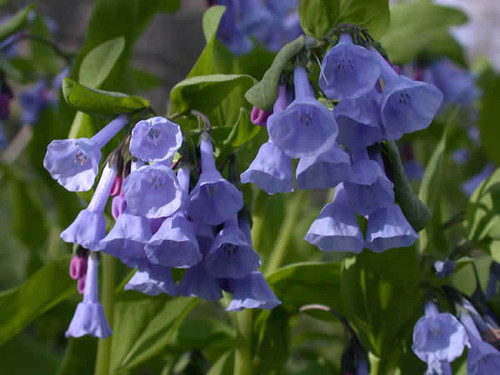Virginia Bluebells
Virginia Bluebells are a common plant found in homes throughout the eastern United States. They prefer rich soils. The bluebells prefer a partially shaded area with moist soils. This perennial has a bright, deep blue color and the blooms look like a small bell. They will start showing their colors in early spring and last until the heat of summer. Many homeowners prefer this perennial because it will show them when spring has arrived.
This perennial has been around for hundreds of years. It was once heard to turned into glue and attaching feathers to arrows. It can get crushed and converted into a starch before starch. This plant has many uses that have been around for years. The flowers can be turned into the sap as glue.
The Mertensia virginica or just Virginia bluebells are one of the most popular and beautiful categories of wildflowers.
Virginia bluebells are considered spring flowers, and after spring blooming, they begin their dormancy before the onslaught of summer. These beautiful bluebells can be found throughout North America’s floodplains and wet woodland areas.
Virginia Bluebells in the Home Garden
If you are looking to grow your own Virginia bluebells at home, then you will be able to as long as you can provide an area that is similar to the conditions that they’re adapted for. This means being able to supply them with either partial or full shade and soil that is very wet and rich in humus.
As you receive your Virginia bluebells, you’ll notice that they are bare root, so you’ll have a much easier time acclimating them to your home garden. Once planted, you’ll need to ensure that they are always in moist soil. The best times for watering are after planting and once new growth begins to break through the ground. After the initial watering, keep an eye on the soil to ensure moistness.
Virginia bluebells is a late spring bloomer and first appears with buds that are pink in color. With a total stalk height of 2 feet, Virginia bluebells will usually begin turning blue shortly after they have finished blooming.
When it comes to growing Virginia bluebells, they are a lot easier than you may think. Underground, Virginia bluebells easily spread by way of their stems as well as the seeds. It is best to wait until fall to divide them. That way, they will be completely dormant. If you don’t plan to separate them, you can just let them be and enjoy them every spring.
Planting Virginia Bluebells
Although Virginia bluebells can re-seed in a home garden, it is not going to be a straightforward procedure. To germinate correctly, the flowers require a little bit of wet, cold weather. You will also need to sow the seeds at least six weeks before your area’s final frost.
Virginia Bluebells is a Pollinator’s Delight
Even though most pollinators are active during the summer months, many pollinators also love to be active during the spring, just as long as the temperature is warm enough. With Virginia bluebells, they make an excellent food source for many spring pollinators such as the butterflies, hummingbirds, and bees. As far as pollination is concerned, this is accomplished by the long-tongue bee and hummingbirds.
Buy Virginia Bluebells Online at Perennial Nursery
Virginia bluebells (Mertensia Virginica) also known as the Virginia Cowslip, are wildflowers that colonize in the moist woodlands of eastern North America. This plant thrives on partial to full shade of light and grows up to 24 inches (60cm) tall.
Here's How to Plant Virginia Bluebells Bare Root
-- Plant in the spring or fall.
-- Plant in moist and wet soil. Once you’ve chosen a spot for the plant, dig to loosen the soil.
-- Plant in an area that’s partial sun and partial shade.
-- Space plants anywhere from 12 to 18 inches apart.
-- Plant so that the top of the root is one inch below the soil line.
Remember, this plant thrives in moist, so depending on rainfall, you should water well after planting, and continue regular watering.
Virginia Bluebells ship bare root.
Plant at time of shipment - Bulb
Climate Zone: 3 to 8
Mature Height: 1.5 to 2 Feet
Mature Width: 1 to 1.5 Feet
Sunlight: Prefers Part Shade to Full Shade
Soil Conditions: Prefers Moist Rich Soil
Botanical Name: Mertensia virginica
FAQ
1. How fast do Virginia Bluebells spread?
A: Virginia Bluebells tend to spread gradually and are often manageable in garden settings. They might take several years to form larger clumps or colonies, and their spreading rate might be influenced by the specific growing conditions and care they receive.
2. When is the best time to plant Virginia Bluebells?
A: The best time to plant Virginia bluebells (Mertensia virginica) is typically in the early spring or fall, preferably when the plants are dormant. Planting during these seasons allows the roots to establish before the heat of summer or the harshness of winte
-
Virginia Bluebells
I have the prettiest bluebells around! So, glad they came with planting instructions
-
Virginia bluebells
The package arrived and the bluebell roots all look great! I can't wait until next spring to see them in bloom. Perennial Nursery did an fantastic job in helping with the order, shipping, and questions. THANK YOU!
-
Virginia bluebells
I had no clue which end of the tuber was up. I called to ask but the number was no good. After asking on FB, I was told to plant them sideways. We'll see.




